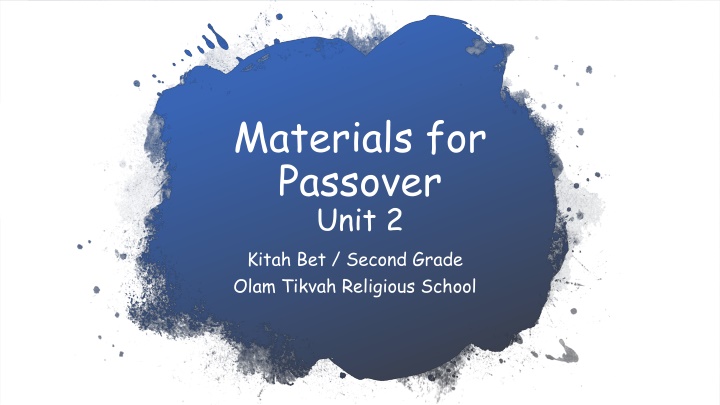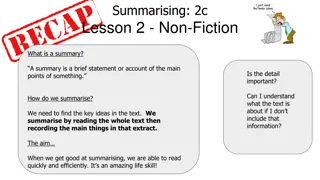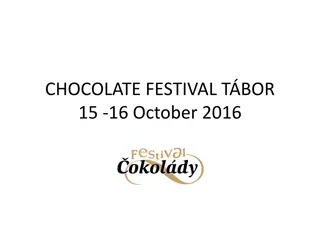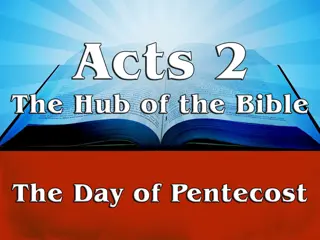Passover Unit 2: Learning Ma Nishtana and Festival of Matzot
Explore Passover traditions in the Kitah Bet/Olam Tikvah Religious School's second-grade curriculum. Learn to sing Ma Nishtana in Hebrew, discover the significance of Passover foods like matzah and bitter herbs, and engage in activities such as making Matzah Brei and Chocolate Matzah cake. Dive into the Festival of Matzot (Chag HaMatzot) and understand the rituals associated with the Passover Seder, including reading the Hagaddah and singing traditional songs.
Download Presentation

Please find below an Image/Link to download the presentation.
The content on the website is provided AS IS for your information and personal use only. It may not be sold, licensed, or shared on other websites without obtaining consent from the author.If you encounter any issues during the download, it is possible that the publisher has removed the file from their server.
You are allowed to download the files provided on this website for personal or commercial use, subject to the condition that they are used lawfully. All files are the property of their respective owners.
The content on the website is provided AS IS for your information and personal use only. It may not be sold, licensed, or shared on other websites without obtaining consent from the author.
E N D
Presentation Transcript
Materials for Passover Unit 2 Kitah Bet / Second Grade Olam Tikvah Religious School
In this unit we will Learn to read and sing Ma Nishtana (the Four Questions) in Hebrew Explore Pessach as the Festival of Matzot: We will learn about Chametz and what to do with it before Passover We will talk about the Afikoman and traditions associated with it We will learn how to make Matzah Brei and Chocolate Matzah cake
At the Passover Seder, we read the Hagaddah and eat symbolic foods. We also sing many songs, some of which we will learn and review here together. First, the youngest child (or children) at the Seder usually sings the Four Questions, also known as Ma Nishtana. We will practice this song together so that you are able to sing it! We will learn the English words and then try to read the Hebrew words. We can also see a table with the Hebrew, the English translation (what the words mean), and the English transliteration (the Hebrew words written in English letters). After we learn the words, we will have the opportunity to sing along with a couple of video clips.
The Four Questions in English: Why is this night different from all other nights? On all other nights we eat leavened products and matzah, and on this night only matzah. On all other nights we eat all vegetables, and on this night only bitter herbs. On all other nights, we don t dip our food even once, and on this night we dip twice. On all other nights we eat sitting or reclining, and on this night we only recline.
Ma Nishtana? ? The Four Questions in Hebrew (try and read them out loud): ? , ( . . ) .
Here you can see the Four Questions in English, in Hebrew, and in English transliteration (=Hebrew written in English letters).
You can now visit the link below and sing together with the words: https://www.youtube.com/watch?time_continue=13&v=JdvF91J Soyg&feature=emb_logo And then . https://www.youtube.com/watch?v=fn3FNA4Ar40
Festival of Matzot (Chag HaMatzot)
Chametz/Khametz Chametz/Khametz These are foods with leavening (raising/rising) agents that are forbidden during Passover. Chametz is a product that is made from one of five types of grain, and that has been combined with water and left to stand raw for longer than eighteen minutes and becomes leavened (=rises). But what if we have a lot of Chametz left at home? How do we get rid of it?
Here are three options: Bi ur (burning): On the night before the 14th of Nisan, a formal bdikat chametz (search/checking for chametz) is conducted around the house by candlelight. The chametz found in this search is burned the next morning, in a formal bi'ur ceremony. Bittul ( cancelling / nullifying ): On the night and again on the morning of the 14th of Nissan, the head of the household recites a statement nullifying(= canceling ) all chametz remaining in the family's possession. Mechirah (selling one's chametz). Jews may sell or give their chametz to a non-Jew. After the holiday, the non-Jew generally sells the chametz back to the original owners ; however, he is under no obligation to do so.
Think for a moment.. What are the benefits of selling chametz to non-Jews (and possibly buying it back later)? Does your family get rid of Chametz before Passover? Do you like Matzah? What kinds of foods or deserts can we make from Matzah to eat during Passover?
Afikoman The Afikoman is a half-piece of matzah which is broken in two during the early stages of the Seder and set aside to be eaten as a dessert after the meal. Afikoman literally means desert in Greek. There are different customs involving the afikomen. In some homes, the head of household may hide the afikoman for the children to find, or alternatively, the children may steal the afikoman and ask for ransom to give it back. Some families (often depending on their countries of origin) have other traditions. What does your family do with the Afikoman? Who hides it? Who has to find it? What kind of prize or ransom is given to whoever finds it?
Matzah Brei (Ma-Tzi-Yah) Matzah Brei is one of the great dishes you can make from Matzah . There are many variations of Matzah Brei, but here s one easy recipe: (It takes about 7 minutes and makes 4 servings) Here s what you will need: 4 matzot 1/2 cup water 4 eggs Salt and pepper 2 tablespoons butter 2 tablespoons kosher for Passover vegetable oil
And heres how you make it: 1. 2. Boil the water and pour it over the matzot, to make them soft . 3. Drain off any excess water (you can do this in a colander). 4. In a bowl, beat the eggs with a fork. 5. Mix the eggs, salt, and pepper into the matzot. 6. Over high heat, heat the butter and oil in a large pan. 7. Add the matzot and fry until crisp. 8. Flip over to fry the other side, breaking into pieces as it cooks. 9. You can serve with Maple syrup, fruit preserves, or with salt. 10. Eat! In a mixing bowl, break each matzah into 1-inch pieces.
And heres how we make Delicious Chocolate Matzah Cake Here s another delicious option for Passover (with your parents supervision) With your parent, prepare these ingredients: 21 oz chocolate bars or Kosher Parve chocolate spread. 7 matzah squares. 1 small bottle sweet kosher wine or grape juice. Then . 1. In a double boiler or the microwave, melt the chocolate bars till smooth (no need to do this if you are using chocolate spread). 2. Pour sweet wine or grape juice into a shallow baking dish/pan. Soak the matzot for 45-60 seconds until they ve absorbed some of the wine or juice. Don t let them soak too long, or they ll get mushy and fall apart! Remove matzot from liquid. 3. Place one moistened matzah in the center of a small tray or plate. 4. Spread the matzah generously with melted chocolate (use a spatula), covering the whole surface of the matzah. 5. Take another matzah and layer it on top, then spread it with chocolate. 6. Repeat the process until you have seven layers of chocolate matzot. 7. Put an extra thick spread of chocolate on the top layer. 8. Optional: top with coconut. 9. Keep refrigerated.
Lets review the Hebrew words weve learned (try to read them out loud): Then try to figure out what word/s in English match each of the Hebrew words/phrases. ? Ma Nishtana? Chametz (leavened bread) Festival of Matzot Night Afikiman (Desert)























